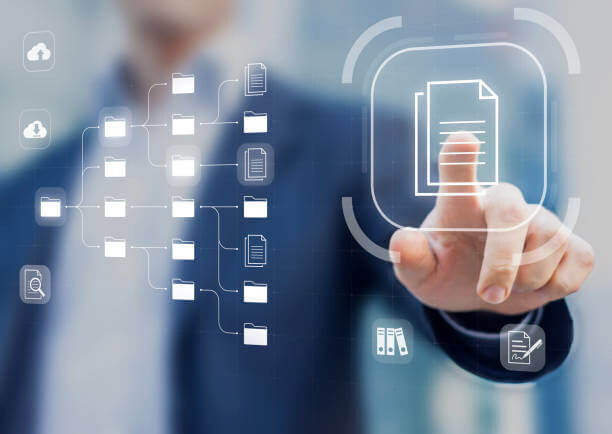Automation is the process of reducing human involvement in a particular activity. Automation can be done via software, hardware, or a combination of both.
Document automation is the process of converting paper-based documents to digital ones. This process includes scanning the document and then converting it into an editable format like PDF or Word file. The benefits of document automation are that it can save time, reduce errors, and improve accuracy.
How do I use document automation?
Document automation software is a type of software that is used for document creation. It can be used by people who are not skilled in document creation or for those who are too busy to create documents on their own. The software uses templates and pre-written content to create documents so that the user can focus on what they want to say instead of having to worry about formatting, layout, etc.
The most common use case for this type of document automation software is when you need a quick contract or letter written. You can use these templates and pre-written content to create your own contracts, letters, agreements, etc.
Document automation is a function that allows users to automate tasks such as formatting, calculations, or document publishing. In order to automate a task, you need to create a macro that will perform the task when triggered.
A macro can be created by recording your actions in Microsoft Word and then saving the macro. This is done by clicking the “Create” button in the Macros menu and then selecting “Record Macro”. After recording your actions, you must save them by clicking the “Stop Recording” button in the Macros menu.
Common misconceptions about document automation
There are many misconceptions about document automation software. The most common ones are that it is expensive, takes a lot of time to set up, and is only for businesses with large volumes of documents.
The truth is that document automation software can be used for any size business. It can also be set up in less than an hour and requires no upfront cost.
Document automation software is software that can be used to create, edit, convert and print documents. This highly efficient software helps organizations maintain control of their document workflow.
What are the benefits of using document automation?
Documentation software is a great tool that can help save time and frustration. It can be used to create and store documents, spreadsheets, presentations and more. It also reduces the need to manually enter repetitive data by up to 60%.
There are many benefits to using document automation in your workflow. Document automation saves time, it’s easy to use, and it’s user-friendly.
Automating your workflow can help you manage your time better because you don’t have to spend time on repetitive tasks like formatting or data entry. You can focus on the more important things in your workday.
How Document Automation Can Cut Your Production Costs And Increase Your Profits (keywords: automated documentation software, automated documentation, digital document automation)
Document automation can cut your production costs and increase your profits. It saves you time and money by automating the process, reducing errors, and improving efficiency.
The benefits of using document automation can be seen in many different ways. For example, it will save you time and money by automating the process, reducing errors, and improving efficiency. Document automation is a great way to increase your profits while also cutting production costs.
There are many different types of document automation software that you can use for different purposes such as: business process management (BPM), enterprise content management (ECM), customer relationship management (CRM), human resources (HR) information systems (HRIS), legal case management systems (LCMS) or financial services business process management systems (FSBM).
Why Document Automation Is the Future of Business Processes
Document Automation software has been around for decades, but it has never been more accessible than it is today. With the help of document automation software, you can automate repetitive tasks and save time and money.
The process of document automation can be broken down into three steps: preparation, execution, and post-processing. The preparation step is when you define what needs to be done or created in your document. The execution step is when the software does what you have defined in the preparation phase. Post-processing is when you review the automated process to make sure that it was done correctly.
Top 3 reasons why you should start documenting your processes now.
- Save time from repeating the same tasks over and over again
- Create a digital footprint for your business
- Automate tedious and repetitive tasks
Document Automation in Logistics Industry
The logistics industry has been a key driver of the global economy. The industry has also been a major contributor to global CO2 emissions, which is why it is crucial that the logistics industry adopts more sustainable practices.
Document automation in logistics can help improve productivity and efficiency by removing the need for paper-based processes and manual data entry.
Logistics companies can now automate a number of their paper-based processes with document automation. This is a cheaper option than having to hire more people and can provide better quality work as it allows them to focus on the actual delivery instead of data entry.
Document automation software can be integrated with existing enterprise resource planning (ERP) systems to automate various business processes, such as inventory management, transportation management, and customer service.
The logistics industry is one of the most difficult industries to manage. There are so many documents that need to be arranged and filed in a way that they can be easily retrieved and found when they are needed.
Luckily, with the help of AI Document Automation software, this process can become much easier. The software will automatically generate documents and fill out all the fields for you which you can export later easily.
The benefits of using this software include: saving time, reducing errors, less paperwork, more accurate information, enhanced security measures which reduce the risk of document tampering or frauds.
ERP vs CRM: Key Differences, Strengths, and How Clavis’ ERP Drives Organizational Success
In the digital age, businesses strive to leverage advanced tools to streamline operations, boost productivity, and foster better customer relationships. Two pivotal software solutions that play a significant role in achieving these goals are Enterprise Resource Planning (ERP) and Customer Relationship Management (CRM) systems. While these tools may seem similar at first glance, they serve distinct purposes and offer unique benefits, and it is important to understand why you may need one or the other—or both in tandem.
1. What is ERP?
ERP stands for Enterprise Resource Planning, a comprehensive software suite that manages and integrates core business processes. These processes often include:
- Finance and accounting
- Human resources
- Supply chain management
- Inventory and order management
- Manufacturing
ERP systems centralise business data, allowing various departments to collaborate seamlessly and make informed decisions based on real-time insights.
Core Features of ERP Systems
- Centralized Data Management: Consolidates information from all business departments into one platform.
- Process Automation: Automates repetitive tasks to improve efficiency.
- Scalability: Can grow with your business, accommodating new functionalities as needed.
- Compliance Support: Helps organisations meet regulatory requirements.
- Advanced Analytics: Provides detailed insights to support strategic decision-making.
2. What is CRM?
CRM, or Customer Relationship Management, is software that focuses on managing a company's interactions with current and potential customers. The primary goal of a CRM system is to improve customer satisfaction, retention, and acquisition through personalised communication and efficient management of sales and marketing activities.
Core Features of CRM Systems
- Contact Management: Maintains detailed records of customer interactions and preferences.
- Sales Pipeline Tracking: Manages leads and monitors the sales process.
- Marketing Automation: Facilitates email campaigns, social media management, and more.
- Customer Support: Enhances post-sale services through ticketing systems and live chats.
- Data-Driven Insights: Helps identify trends to fine-tune marketing and sales strategies.
3. ERP vs. CRM: Key Differences
While ERP and CRM are essential for business success, they cater to different aspects of operations.
|
Feature |
ERP |
CRM |
|
Primary Focus |
Internal processes and operational efficiency |
Customer interactions and relationships |
|
Key Functions |
Accounting, supply chain, HR, inventory |
Sales, marketing, customer service |
|
Target Audience |
Internal stakeholders |
Sales, marketing, and customer support teams |
|
Data Integration |
Focuses on consolidating operational data |
Specialises in customer-centric data |
|
Scalability |
Enterprise-wide |
Primarily focused on customer management |
4. The Strengths of ERP Systems
ERP systems are the backbone of operational efficiency. Their key strengths include:
- Holistic Business View: ERP provides a comprehensive view of business operations by integrating data across departments.
- Cost Reduction: Automating processes reduces manual labour and errors, saving time and money.
- Improved Compliance: Centralized data simplifies regulatory reporting and ensures adherence to standards.
- Inventory Optimization: Enhances inventory management, reducing waste and ensuring timely procurement.
- Agile Decision-Making: Real-time data insights help leaders make swift, informed decisions.
5. The Strengths of CRM Systems
CRM systems shine in the realm of customer relationship management, with benefits such as:
- Enhanced Customer Insights: Tracks and analyses customer preferences to tailor interactions.
- Improved Customer Retention: Personalization and timely communication foster loyalty.
- Streamlined Sales Processes: Automates lead management, reducing manual intervention.
- Marketing Optimization: Helps segment audiences for targeted campaigns.
- Boosted Collaboration: Facilitates alignment between sales and marketing teams.
6. ERP and CRM: Complementary Tools
Though distinct, ERP and CRM systems are complementary and often integrated to deliver maximum value. For instance:
- CRM manages the front-end relationship with customers, while ERP handles back-end processes like inventory and order fulfilment.
- Together, they provide a seamless flow of information, ensuring that customer-facing teams have accurate, up-to-date data on orders and services.
7. Clavis' ERP: The Ultimate Solution for Organizational Success
Clavis' ERP stands out as a robust ERP solution designed to address the multifaceted needs of modern businesses. Here’s how it can drive your organisation's success:
a) Comprehensive Integration
Clavis' ERP integrates seamlessly with existing systems, including CRM platforms, to unify your business processes.
b) Real-Time Data Analytics
With Clavis' ERP, decision-makers can access advanced analytics tools that offer actionable insights into performance, trends, and potential opportunities.
c) Tailored Functionality
Highly customisable to suit the unique needs of businesses across industries, Clavis' ERP works for all—from manufacturing to retail and more.
d) Enhanced User Experience
The platform boasts an intuitive interface, making it easy for employees to adopt and use effectively.
e) Cloud Capabilities
Leverage cloud-based deployment for flexibility, scalability, and cost savings.
9. Choosing the Right Solution for Your Business
When deciding between ERP and CRM—or opting for an integrated approach—consider the following:
- Business Goals: Identify whether your primary focus is operational efficiency (ERP) or customer relationships (CRM).
- Scalability: Choose a solution that can grow with your business.
- Budget: Evaluate the total cost of ownership, including deployment and maintenance.
- Customization: Ensure the platform can be tailored to your specific needs.
Final Thoughts
ERP and CRM systems are indispensable for businesses aiming to optimise operations and enhance customer relationships. While they serve distinct purposes, their integration offers unparalleled value. With Clavis' ERP, you gain a robust tool that streamlines your operations and integrates seamlessly with CRM systems to provide a holistic business solution.
Some other posts you might be interested in.

Mauritius and MNIC 3.0 – Driving the Digital Transformation in East Africa
On February 26, 2024, the Prime Minister of Mauritius, Mr Pravind Kumar Jugnauth, unveiled MNIC 3.0, the latest iteration of the Mauritius National Identity card. Speaking on the occasion, the Prime Minister stated, “The new card reflects our commitment to modernity,...

CMS and DAM: Why your business needs both
With the enhancement of technology, consumers require flawless experiences in everything they do. Be it at home, with their smartphone, car, or work-space, the ease of handling tasks should be at the snap of a finger. To have a seamless experience at the workspace,...

15 Applications of Blockchain in Healthcare
"Blockchain" refers to a shared irreversible record of a chain of transactions, each of which is made up of one block, and which is held together by cryptographic keys ("hashes"). These keys or signatures are maintained in shared ledgers and connected by a network of...
